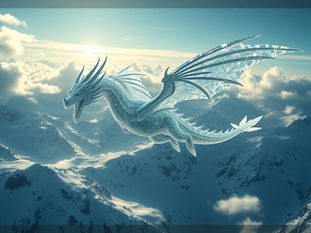
Making Dynamic Videos in Midjourney: Loop and Start-End Frames
Jul 29
4 min read
0
91
0

Midjourney keeps adding new tools, and that's great for creators. The introduction of loop and start-end frame features gives you new ways to shape your videos. You can now make your visuals more dynamic and visually surprising. Even with Midjourney's interface changing often, these new features help you create amazing content today.
Getting Started with Midjourney Videos
Midjourney offers several ways to create videos from your images. It is helpful to see real-world examples, both good and not-so-good, to understand what works best. Always remember the limits of these tools to avoid choppy movements or messy changes in your animations.
Examples of Looping Videos
The looping feature in Midjourney is a standout aspect. It works best when the motion feels naturally repetitive, like cars moving in circles or objects rotating. Here are a few examples:
[LI]A fight between an orc and a human: This simple and fun animation works effectively, showing a surprising encounter.[/LI>
[/UL]
Examples of Start and End Frame Videos
The start and end frame feature allows for transformations between two distinct visuals. Let's look at how it performs:
[LI]Origami rhino armor activation: The rhino changes from realism to stylized paper. This is a strong visual change and a clear success.[/LI>
[LI]Post-apocalyptic frozen building: While the camera movement looks good, Midjourney had to rebuild parts of the structure during the animation, which broke the effect. This example was not successful.[/LI>
[LI]Supermarket standoff with a bear: This video, presented in a CCTV style, is surprisingly polished. The lighting, setup, and timing all worked well, making it a success.[/LI]
[LI]Sci-fi ships orbiting Earth: When used carefully, start and end frames can create dramatic scenes like this one, where ships glide peacefully until a wave of fire erupts. This produced a visually stunning result.[/LI]
[/UL]
How to Create Videos in Midjourney
There are four main ways to create videos in Midjourney:
[LI>Click on an image, and in the bottom right panel, you will see "animate image." From here, you can select "auto," "low or high motion," "loop (low or high motion)," or "manual." Auto and loop options use Midjourney’s internal logic, so you cannot input prompts. If you choose manual, your image becomes the starting frame and the original prompt is used again.[/LI]
[LI]Drag any image directly into the "starting frame" field at the top.[/LI>
[/UL]
If you are finding the process of creating and managing your Midjourney videos time-consuming, consider exploring the Midjourney Automation Suite from TitanXT. It can help streamline your workflow and enhance your creative output.
Using Start and End Frames: A Detailed Look
Start and end frames only work in manual mode. First, upload an external image. It will appear in the "starting frame" field. To the right, you will see a second field for the "ending frame" and an optional checkbox for "loop." Checking "loop" makes the ending frame disappear.
[P]There are two approaches to using this feature:[/P>
[LI]Version One (Simpler): You create two images, either new or based on the same idea, and drag them into the starting and ending frame slots. If they are not too different, the change usually works well.[/LI>
[LI]Version Two (More Control): This takes more effort but gives you better results. First, create an image in Midjourney. Pick one of the four options and animate it using auto or manual mode. Once the animation finishes, download the video and extract the very last frame (you can use a tool like Photoshop for this). This final frame becomes your starting point for improvements. Upload this extracted frame into Midjourney's external image editor and make changes. For example, you could add a helmet to a rider. Then, go back to Midjourney’s animation panel. Drag your original image as the start frame and your modified version as the end frame. Generate the new video. The result will show your changes smoothly.[/LI]
[/UL]
In manual mode, you can also change the prompt above the video panel. Be careful what you write; if your start frame shows a horse and your prompt mentions a plane landing, the video will not make sense. The animation always lasts 5 seconds. This short window means trying to tell a long story usually does not work. It’s better to keep things simple and build your video in small steps. This approach keeps the pacing natural and gives the AI room to create the visuals. For instance, a video showing a horse running into a town and winning a rodeo worked surprisingly well. However, a prompt about a horse diving into the ocean with a diver close behind was visually complex and did not turn out as well.
[P]Before you generate your video, remember to choose between "low" or "high motion" on the right side. This controls how active the animation will be. The results can vary a lot depending on your scene.[/P>
Understanding Loops in Midjourney
Midjourney can create proper loops with the latest update, but, as always, the outcomes depend on your scene. Take a horse running across a field, which sounds perfect for a loop. In "low motion," the horse might jump forward, pause, then slide back to its original spot to finish the loop. This looks odd, as if the horse started too early.
In "high motion," the loop looks more natural. The horse keeps running, and the movement feels better. However, near the end, there might be a small pause and some color changes that break the smooth effect.
Creating loops is straightforward:
In auto mode: Just pick "loop" (low or high), and Midjourney does the work.
In manual mode: Drag in a starting frame, check the "loop" box, and hit generate.
To truly elevate your Midjourney projects and handle complex looping or frame-by-frame adjustments more efficiently, consider the Midjourney Automation Suite from TitanXT. It is designed to help you automate and improve your creative process.
Ready to Take Your Midjourney Creations Further?
Midjourney is releasing strong features that open up new ways to create. Many creators are hoping for future updates that include sound and voice for videos, which would add another dimension to storytelling. Until then, tools like Runways Act 2 help with adding audio.
Experiment with these new looping and start-end frame features in Midjourney to make your visuals stand out. By understanding how they work and their limits, you can create impressive, dynamic video content.
For those looking to optimize their Midjourney workflow and make the most of these powerful features, our Midjourney Automation Suite from TitanXT provides tools to help you create at a new level. Explore how it can simplify your creative process today!






